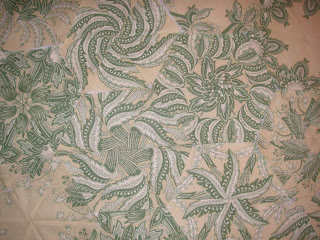 Here are two details from the work in progress [WIP] in the previous post. Often I do not quite know what I'm doing, i.e. I haven't defined what my action and expectation is. In terms of this quilt I haven't defined it's antecedents either and they deserve to be given credit. I called it the "hexagon quilt." I should call it my Second Maxine Rosenthal quilt. I have been inspired by One Block Wonder, her book which shows examples and gives directions for quilts of this sort. I am especially thinking about what I am doing because, as this second quilt is on the design wall, I am actually quilting #One [Ive shown it before and will show it again when I'm doing quilting it].
Here are two details from the work in progress [WIP] in the previous post. Often I do not quite know what I'm doing, i.e. I haven't defined what my action and expectation is. In terms of this quilt I haven't defined it's antecedents either and they deserve to be given credit. I called it the "hexagon quilt." I should call it my Second Maxine Rosenthal quilt. I have been inspired by One Block Wonder, her book which shows examples and gives directions for quilts of this sort. I am especially thinking about what I am doing because, as this second quilt is on the design wall, I am actually quilting #One [Ive shown it before and will show it again when I'm doing quilting it].
Maxine R. follows in the footsteps of two well known quilters, and adds her own creative approach. First there was Paul Nadelson, a true quilt artist of the first important generation of late 20th century quilt artists. [Not that they are fossils, all are still much among us and still creating]. Paula's kaleidoscope quilts were laboriously cut and sewn and became iconic -- so much so, she was copied by a carpet manufacturing company who she had to sue for the royalties she very much deserved. Many years ago I head Paula speak of her laborious construction methods -- carried out in a crowded Bronx apartment amidst all her family duties. I was in awe.
Then came Bethany Reynolds and her "stack and whack" method [it should have a copyright sign affixed but my program doesn't have one for me to insert]. Bethany is a technological creator. She made Paula's painstaking methods easier, although not exactly super easy and not as complex. I have used Bethany's books and her methods several times and I've had a wonderful time making quilts with her technique.
 Maxine Rosenthal uses Bethany's cutting technique but handles the resulting kaleidoscope-like hexagons or octagons differently to create a more abstract, exciting pattern than those Bethany offers in a more traditional block quilt tradition.
Maxine Rosenthal uses Bethany's cutting technique but handles the resulting kaleidoscope-like hexagons or octagons differently to create a more abstract, exciting pattern than those Bethany offers in a more traditional block quilt tradition.And where do I fit in? I'm a quilt hobbyist who has a bundle of fun making these quilts. I love the development of the kaleidoscope patterns and then the arrangement of them in the whole. I am neither an artist nor an innovator, I am an enjoyer, a recipient of others' wonderful talents. They have enriched my free time when I sew these quilts, and have expanded my artistic ability to arrange the hexagons in pleasing patterns. Too often, I think, people like me who learn something new from either a class or a book, imagine ourselves to be artists. No, we are artisans, we are enjoyers, and we should give thanks as well as credit where it is due.







3 comments :
Thank you for reminding me of that useful word "artisan". I tend to say that "I am not an artist, I'm a crafter", but to many people "crafter" is a disparaging term suggesting someone who just dabbles in a hobby. I like "artisan" much better, with its implication of pride in our skill with our hands.
Artisan is a good word. I agree with jennyk that the term "crafter" is often used in a derogatory sense, which is unfortunate since we need a term to describe what we do. Artisan might fit.
BTW, the kaleidoscope blocks are really fun, aren't they? I find them quite addictive.
Thanks for the pep talk, June, and thanks for posting the information. The one thing I know is that things continue to evolve and there's no end to the creativity. Here's to more...
Post a Comment